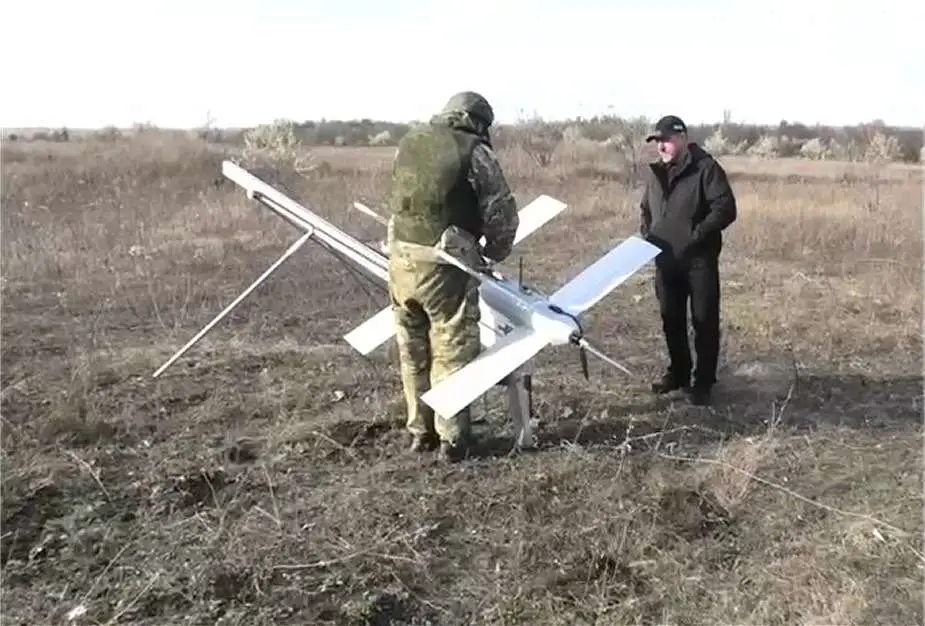A video released on the Russian social media platform Telegram on November 28, 2023, reveals the deployment of the new Scalpel loitering munition by Russian forces in Ukraine. This development signifies a notable transformation in contemporary warfare strategies and technologies, particularly highlighting the evolving role of loitering munitions in the Russian military's operations.
Follow Army Recognition on Google News at this link

The new Russian-made Scalpel loitering munition is now deployed by Russian Forces on the Ukrainian battlefield. (Picture source Telegram)
Loitering munitions, often called "kamikaze drones," blend the characteristics of drones and guided missiles, and have been in development since the late 20th century. Initially, these systems were pioneered by countries like the United States and Israel, designed to bridge the gap between traditional air-delivered munitions and unmanned aerial vehicles (UAVs).
In the context of the Russia-Ukraine conflict, the use of these munitions by the Russian military has evolved considerably. Initially, the Russian armed forces were known more for their conventional warfare tactics, relying heavily on artillery and armored units. However, the changing nature of warfare, which increasingly emphasizes precision, low cost, and reduced risk to personnel, has led to a greater reliance on advanced technology like loitering munitions.
The Russian military's adoption of these systems reflects a strategic shift towards asymmetric warfare tactics, where such munitions offer a significant advantage. Loitering munitions are capable of lingering over a target area for an extended period, identifying and striking targets with high precision. This capability is particularly useful in a conflict like that in Ukraine, where identifying and engaging dynamic or hidden targets is crucial.
Moreover, the use of loitering munitions by Russia in Ukraine demonstrates an adaptation to modern warfare's technological advancements. These weapons provide a cost-effective means to inflict damage while minimizing the risk to personnel and high-value equipment. They are especially useful in environments where traditional air defense systems are strong, as their smaller size and lower flight profiles make them harder to detect and intercept.
The Scalpel loitering munition, while bearing resemblance in design and structure to existing Lancet models, distinguishes itself through unique features and advantages. It excels in certain aspects and capabilities, surpassing other Russian-made light drones, and is noted for its relatively affordable cost.
A key highlight of the Scalpel project is its modular approach to combat loadouts. Its ample cargo space allows for the accommodation of various types of warheads, tailored for different objectives. This versatility enhances the unmanned platform's ability to engage a broader array of targets effectively. Moreover, operators have the flexibility to choose warheads based on current needs and available ammunition.
In terms of technical specifications, the Scalpel impressively outperforms many existing models. Notably, its maximum payload capacity of 5 kg constitutes over 45% of the drone's launch weight. For context, the heavier Lancet model carries a 3 kg warhead, which is only 25% of its total weight.
The Scalpel's flight capabilities are robust enough to fulfill key combat roles. Capable of striking targets several tens of kilometers away, it can reach its maximum range in just 18-20 minutes. After arriving, it can commence patrolling and target acquisition. While it may fall short in range and speed compared to some modern warheads, these limitations are offset by other design elements.
Overall, the Scalpel is not so much a rival to the Lancet but rather a complementary asset. Each drone with its distinct characteristics and capabilities, can be deployed synergistically depending on the tactical scenario. In certain situations, the Lancet with its standard warhead is ideal, whereas in others, the more robust Scalpel, equipped with a specifically chosen combat load, is more suitable.
News Russia Ukraine War















